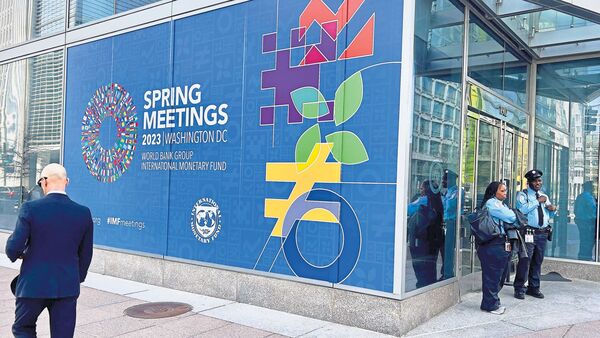This week, ministers and officials worldwide will assemble in Washington, DC, for the Spring Meetings of the International Monetary Fund (IMF) and the World Bank. G20 nations will also hold their second Finance Ministers and Central Bank Governors meeting under the Indian Presidency during the same week.
Globally, many low-income countries are still dealing with the economic aftermath of the pandemic and successive inflation and interest-rate shocks. Their growth prospects remain cloudy at best and rather dim at worst. Their debt burdens have not become lighter. Their currencies remain prone to further weakness. These countries are nervous about their macroeconomic and social stability and anxious about their growth prospects. Amid these preoccupations, many face pressure to transition to an energy future free from fossil fuels. They seek financial, technological and material resources to undertake this transition.
Although it has been difficult for the world’s richer countries to implement policies to phase out fossil-fuel usage and adhere to carbon-reduction timelines, expectations that less-rich countries somehow do so have not diminished. Developed countries, in good faith, promised to provide financial resources to developing countries in an implicit recognition of their role in the elevated existential risk that the planet faces from volatile temperature shifts. But, facing the prospect of structurally lower growth, ageing populations, higher debt and contingent pension obligations, they have not been able to deliver on their commitment. Instead, they expect and are pressing multilateral development banks (MDB) to step in and make up for the shortfall. International financial institutions (IFIs) need funds that they can leverage and lend to others. They are also expected to catalyse private sector flows to low-income countries to finance their energy transition.
Conceptually attractive, the proposal looks less appealing when subject to the scrutiny of both practical feasibility and desirability. In general, the private financial sector has neither been particularly successful nor interested in funding socially and economically transformational projects in the developing world. The reconstruction of countries ravaged by World War II was funded by MDBs founded in its wake and aid from the US. Second, private financial capital has not proven itself efficient in allocating capital. It has frequently fomented asset bubbles, with monetary and fiscal authorities having to step in to mop up the debris afterwards. This has happened all too frequently in the new millennium.
Plentiful capital supplied by the central banks of rich nations at zero interest rates has fuelled investment adventures in far-off frontiers since the birth of the new millennium. If interest rates do not revisit those lows for some time now, it would be difficult to visualize private capital funding socially and economically purposeful transition projects in strange lands. Even if they do, the price they would extract might be unaffordable for their intended beneficiaries. To make the whole thing work, private capital flows must be de-risked by IFIs. But, both investors and their targets need de-risking. Resources are finite, and there is a moral hazard in de-risking. De-risking creates the risk of socialization of losses and privatization of gains. If private-sector investment risk is to be lowered, the quid pro quo demanded of the sector should be clearly spelt out. De-risking cannot be only for encouraging flows, but also has to result in retention (long-term investing) and nurturing. The latter means that host-country assets are not hollowed out to reward shareholders. Even some advanced countries have struggled with these issues and those memories are not ancient.
We may be placing too high a burden of expectations on private capital to provide affordable, de-risked (for hosts) and long-term capital to finance the energy transition. Private horizons are usually short and considerations often myopic. Recently, The Wall Street Journal told us (on.wsj.com/3UlEIh8) that investors in Uber told the company’s CEO that he was spending too much and needed to rein in costs after he carved out bonuses of $250 million to entice drivers.
Some de-risking can benefit both investors and destination countries. Currency risk is a case in point. Exchange rate collapses, especially those aggravated by speculation (ahem, by financial sector traders), bring economic misery and cause investors to flee. Countries need special, unstigmatized arrangements for currency-misalignment risks to be minimized. That would be worthwhile.
Attracting private capital from abroad means countries run current account deficits (CAD). How large can the CAD get before it makes financial markets nervous and for risk premia to rise? What is the sustainable current-account-deficit level for an energy transition that contributes to the planet’s sustainability? How can it be ensured that short-term currency and fixed-income traders and credit rating agencies understand this? How do we ensure their short-term incentives align with global inter-generational imperatives? Further, it is strange to see ideas emerge for further external debt—especially from private sources—to be loaded onto countries when they are buckling under the weight of accumulated debt. We need to think through these issues before we end up rushing through them.
About 12 years ago, 1,000 economists from 53 countries felt that the link between the financial sector and society was broken and that it was time to fix this link and for the financial sector to give something back to society. It is up to the global financial sector to take them seriously, at least now.
These are the author’s personal views.
V. Anantha Nageswaran is chief economic advisor to the Government of India
Download The Mint News App to get Daily Market Updates.
More
Less
#private #capital #work #global #public #goods
